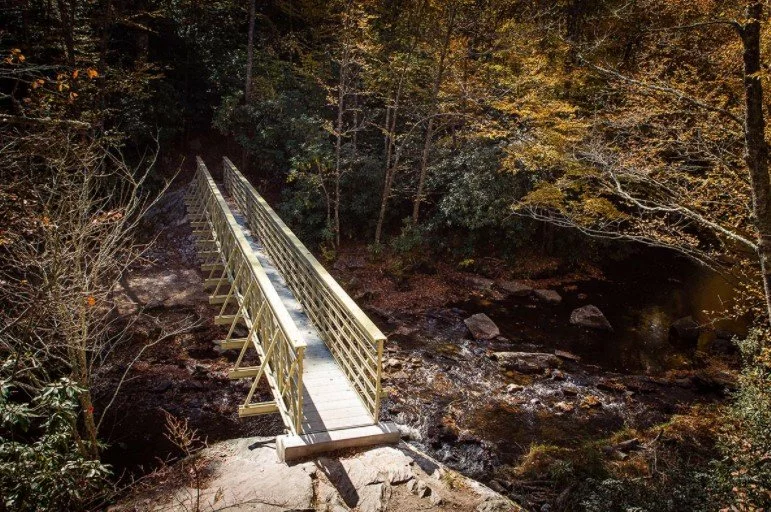Hiking trail bridges are necessary for parks and trails since they allow for a safe crossing over streams, rivers, wetlands, ravines, and other environmental features. As you begin preparing for this project, make sure to take into consideration crucial bridge elements like material, sizing, onsite location, and aesthetics. Those elements play a fundamental role in your hiking trail bridge design.
Bridge Design Considerations
When reviewing bridge options, you’ll want to look at the “big picture” when selecting the material. This is because the chosen material influences most aspects of the bridge project from transportation, environmental impacts, and appearance.
#1 Material Choices
The three most popular materials on the market for hiking trails bridges are fiber reinforced polymer (FRP), steel, and wood.
Fiber Reinforced Polymer (FRP)
FRP is a corrosion-resistant material that boasts a 100+ year lifespan. As a result, the material works exceptionally well for remote pedestrian crossings since it requires minimal maintenance. Learn more about FRP bridges.
Steel
Steel provides a long lifespan with low maintenance, but bridge construction is challenging on remote trail systems because steel bridge parts are heavy, making it difficult to transport and necessitating heavy equipment to construct the bridge. In some cases, a road may even need to be built just for this heavy erection equipment to access the location.
Wood
Wood bridges provide a lifespan of about 30 years. During that time, it will require frequent maintenance.
#2 Bridge Location
You’ll need to consider the below location factors when designing your hiking trail bridge.
- Is the bridge location remote, urban, or in a well-populated area?
- How will you transport the materials to the bridge site?
- If heavy machinery is needed, how will it arrive at the bridge site?
#3 Dimension and Load Considerations
The bridge’s dimensions and weight play a significant factor in the overall design. Make sure to know the following details before beginning your design process.
Dimension Questions
- How much distance will the bridge need to span? (This is often underestimated.)
- Does the bridge need to cross a body of water?
- Do you need to conduct an environmental study?
- How wide does the bridge need to be based on how many pedestrians, bikes, golf carts, maintenance vehicles will it need to accommodate?
- Are handrails needed?
Load Questions
- Does it need to support the weight of foot traffic, lightweight vehicles, bikers?
- How much snow will it need to hold?
- What are the expected wind loads for the bridge?
#4 Aesthetics
Having a functional bridge with an appealing appearance creates a perfect hiking trail bridge. To ensure you have an aesthetically pleasing bridge that doesn’t impede the surrounding view, you’ll want to choose a material that has a color that compliments the environment, doesn’t corrode over time, and won’t require constant maintenance to upkeep its appearance.
Why Choose FRP?
As mentioned above, FRP is growing in popularity for trail bridges leading to the question, ‘what makes this material the best option’?
Easy to Transport and Assemble
Thanks to its lightweight properties (which is a quarter of the weight of steel), the pieces can easily be transported by hand to remote locations—saving you a considerable amount on transportation costs. In addition, all the FRP parts are prefabricated. When they arrive on-site, you can use hand tools and unskilled labor to assemble the bridge, lowering your overall labor costs.
High Durability with Low Maintenance
While there is a higher upfront cost for FRP bridges, the price is offset, thanks to its long lifespan. FRP is made to handle harsh weather conditions without deteriorating or needing constant maintenance. Once the bridge is installed, it only requires minimal maintenance during its 100+ year life.
Request a Quote for Your Hiking Trail Bridge Design
Now that you have more information on what to consider for your trail bridge, the Areté Structures team can help you take the following steps. Request a quote today for your hiking trail bridge design.

